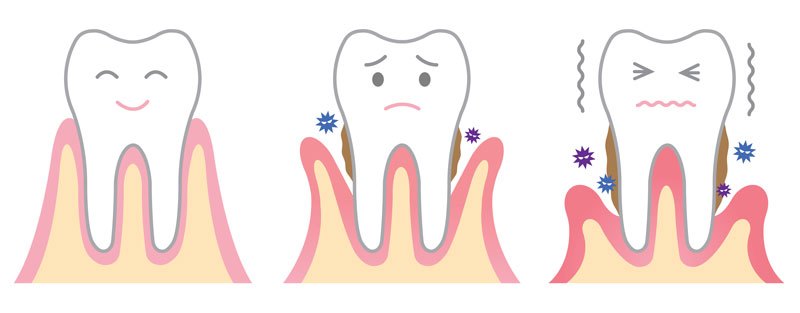Contrary to popular belief, gum disease is anything but a rarity. In fact, the overwhelming majority of adults will develop gum disease to one extent or another during the course of their life. It’s comparatively rare for anyone not to present the signs and symptoms of gum disease, the severity of which will vary from one individual to the next.
But what’s interesting is how despite the fact that gum disease is one of the most common conditions in the world, most people know comparatively little about it. They know it exists, but have little to no idea how to detect it, how to treat it or why it’s important to do so. Which is why we thought we’d share an introductory FAQ – a few facts and guidelines on the subject of gum disease.
What are the symptoms and signs of gum disease?
The biggest problem with gum disease is the fact that most people have no idea they have it, until it is brought to their attention by their dentists. Or in some cases, when the signs and symptoms become so advanced that they become much more easily identifiable. In many instances, simply glancing at the teeth and gums as you might do on a daily basis isn’t enough to detect the early signs and symptoms of gum disease. In its earliest stages, it isn’t easy to pick up on at all.
Dentists, however, are trained to look for the signs and symptoms you yourself may miss. Nevertheless, it’s important to check proactively for the most common signs and symptoms of all, which include the following:
- First of all, when the gum around the tooth is affected by gum disease, it separates from the tooth and creates a space in-between known as a pocket. As these pockets are relatively small, they can be difficult to see. They are, nonetheless, extremely problematic.
- The first warning sign most people pick up on when it comes to gum disease is bleeding. Contrary to popular belief, it is neither normal nor healthy for the gums to bleed on a regular basis. In fact, even noticing blood on your toothbrush once should be enough to prompt further investigations. More often than not, bleeding gums picked up on early enough represent an early sign of gum disease which can easily be treated. The longer you ignore it, the worse the problem becomes and the greater the damage done.
- Loose teeth. Likewise, there is no good reason why any of the teeth in your mouth should be any looser than any others. If they are, there’s a chance it could be the result of gum disease. If not, it’s still highly probable that there is something untoward occurring that should be investigated as soon as possible.
- Bad Breath. Another common warning sign of gum disease is bad breath. You may not notice the problem yourself, but if others are giving you any indication that you have breath issues that cannot be explained any other way, it could be that you have gum disease. Either way, on-going or severe bad breath is a problem that should not be ignored.
What causes gum disease (periodontitis)?
So given that it is so incredibly common, what is it that cause of gum disease in the first place? In short, it’s the way in which dental plaque is constantly forming and accumulating all over our mouths. It sticks to the teeth, irritates the gums and has the potential to cause infection. When plaque isn’t effectively removed on a daily basis, it slowly but surely transforms into tartar. The problem being that tartar cannot be removed by conventional brushing or flossing – you need professional cleaning to get rid of it effectively.
Over time, plaque and tartar contribute to the gums slowly but surely pulling away from the teeth. Food and other debris collect in the gaps and pockets, bacteria and plaque thrive and ultimately do a number on the health of your teeth and gums.
Is gum disease serious?
When detected early enough and properly maintained, gum disease is not necessarily dangerous. However, if overlooked or ignored for enough time, it can become an entirely more serious issue. From tooth loss to the destruction of jawbone matter to infections to abscesses and so on, advanced gum disease can be extremely serious. In its later stages, gum disease has even been linked with more serious conditions like diabetes and cardiovascular disease.
How is gum disease treated?
Unfortunately, there is no such thing as an outright ‘cure’ for gum disease. That said, it is relatively easy to bring under control and manage with everyday maintenance. If you suspect you may have gum disease, the first thing to do is speak to your dentist. Chances are, they will carry out a more thorough investigation, diagnose the problem and carry out a professional cleaning if necessary. After this, it is simply a case of improving your own everyday dental hygiene regime.
For example, the single most important thing you can do to keep gum disease under control is brush and floss comprehensively, twice a day and with the best possible products you can lay your hands on. Choose the very best electric toothbrush for gingivitis, a quality antibacterial mouthwash for gum disease and dental floss or a water flosser approved and recommended by your dentist. Try to get into the habit of flossing after eating, chewing gum throughout the day and generally investing as much effort as necessary in keeping your teeth and gums healthy.
Or if things have become particularly advanced, there may be the option of various surgical procedures. These are usually unnecessary, though can be discussed with your dentist if you are facing a particularly severe problem with receding gums. Nevertheless, identify and address gum disease early enough and things need never get this far.
